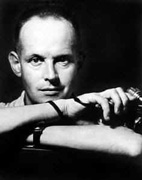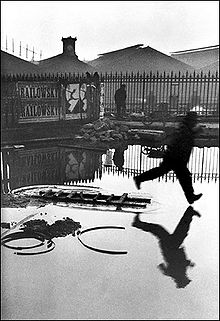21:55 Henry Cartier-Bresson | |
His pictures and picture essays have been published in most of the world’s major magazines during three decades, and Cartier-Bresson prints have hung in the leading art museums of the United States and Europe (his monumental ‘The Decisive Moment’ show being the first photographic exhibit ever to be displayed in the halls of the Louvre). In the practical world of picture marketing, Cartier-Bresson left his imprint as well: he was one of the founders and a former president of Magnum, a cooperative picture agency of New York and Paris. Henri Cartier-Bresson was born in 1908, in Chanteloupe, France, of prosperous middle-class parents. He owned a Box Brownie as a boy, using it for taking holiday snapshots, and later experimented with a 3 X 4 view camera. But he was also interested in painting and studied for two years in a Paris studio. This early training in art helped develop the subtle and sensitive eye for composition, which was one of his greatest assets as a photographer. In 1931, at the age of 22, Cartier-Bresson spent a year as a hunter in the West African bush. Catching a case of backwater fever, he returned to France to convalesce. It was at this time, in Marseille, that he first truly discovered photography. He obtained a Leica and began snapping a few pictures with it. It was a pivotal experience. A new world, a new kind of seeing, spontaneous and unpredictable, opened up to him through the narrow rectangle of the 35 mm viewfinder. His imagination caught fire. He recalls how he excitedly "prowled the streets all day, feeling very strung-up and ready to pounce, determined to ‘trap’ life, to preserve life in the act of living. "Resuming his interrupted career as a photojournalist, he helped form the Magnum picture agency in 1947. Assignments for major magazines would take him on global travels, across Europe and the United States, to India, Russia and China. Many books of Cartier-Bresson photographs were published in the 50’s and 60’s, the most famous being ‘The Decisive Moment’ (1952). A major milestone in his career was a massive, 400-print retrospective exhibition, which toured the United States in 1960. Cartier-Bresson died in Céreste (Alpes-de-Haute-Provence, France) on August 3, 2004 at the age of 95. | |
|
| |
| Total comments: 0 | |

 Henri Cartier-Bresson (August 22, 1908 – August 3, 2004) one of the greatest photographers of his time was a French photographer considered to be the father of modern photojournalism, an early adopter of 35 mm format and the master of candid photography. He helped develop the "street photography" or "real life reportage" style that has influenced generations of photographers that followed.
Henri Cartier-Bresson (August 22, 1908 – August 3, 2004) one of the greatest photographers of his time was a French photographer considered to be the father of modern photojournalism, an early adopter of 35 mm format and the master of candid photography. He helped develop the "street photography" or "real life reportage" style that has influenced generations of photographers that followed. "In photography, the smallest thing can be a great subject," he wrote in ‘The Decisive Moment’. "The little human detail can become a leitmotif." Most of his photography is a collection of such little, human details; concerned images with universal meaning and suggestion. He lived in a haunted world where mundane facts, a reflection in a mud-puddle, an image chalked on a wall, the slant of a black-robed figure against mist, radiate significance at once familiar and only half-consciously grasped. His was an anti-romantic poetry of vision, which finds beauty in "things as they are," in the reality of here and now.
"In photography, the smallest thing can be a great subject," he wrote in ‘The Decisive Moment’. "The little human detail can become a leitmotif." Most of his photography is a collection of such little, human details; concerned images with universal meaning and suggestion. He lived in a haunted world where mundane facts, a reflection in a mud-puddle, an image chalked on a wall, the slant of a black-robed figure against mist, radiate significance at once familiar and only half-consciously grasped. His was an anti-romantic poetry of vision, which finds beauty in "things as they are," in the reality of here and now.